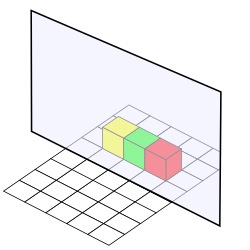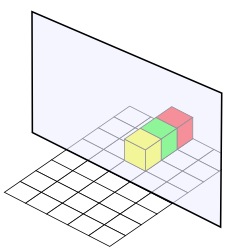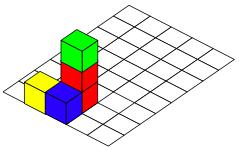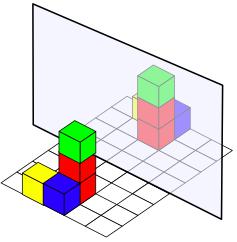Or search by topic
Number and algebra
Geometry and measure
Probability and statistics
Working mathematically
Advanced mathematics
For younger learners
Reflector ! Rotcelfer



- Problem
- Getting Started
- Teachers' Resources
Reflector ! Rotcelfer
An activity for two, three or four pupils working together.

Well, that's three photos of three different ways of putting some blocks together. But there's a mirror behind the black strip. In the mirror you can see the reflections.
Now here are some more pictures but only the reflection is shown and you have to place blocks that will make this reflection.


Now here are two that will probably need more careful thinking.

So, one of your group makes a model, maybe something like this;

You therefore make it like the one behind the mirror, as here;

Why do this problem?
Possible approach
Show one of the images of the reflected cubes to the class. Discuss what the picture is showing us - we can see a mirror and a reflection, but we don't know what the original arrangement was. What could it have been? Encourage pupils to explore this in pairs, giving reasons for their ideas. Choose a child to describe their thinking to the class, drawing or making the arrangement of cubes and
explaining how they know where the cubes should be.
Hand out the other three pictures (all four pictures can be downloaded as a word or pdf file) In groups, pupils could make the reflection and the original arrangements for each one with coloured cubes, putting these cubes on large squared paper with a mirror in between
the two arrangements. Once a group has completed all three arrangements, they can explain their solutions to an adult before moving on to the next step of making their own arrangements. Each child then takes it in turns to make a cube arrangement on one side of the mirror, with the rest of the group working together to make the reflection on the other side.
Bring the class back together at the end of the lesson to discuss their learning. What strategies did pupils find helpful for working out where the reflected shape would be?
Key questions
How can you decide what goes where?
How many squares are there between that block and the mirror line?
Which cube is next to that cube in the reflection?
Tell me about your answer.
Possible extension
This activity can easily be extended by adding to the number of blocks used by one of the group when the others are trying to produce the reflection.
Possible support
Some children might benefit from having the original arrangements made for them out of cubes, rather than starting from the pictures.
You may also like
Times
Which times on a digital clock have a line of symmetry? Which look the same upside-down? You might like to try this investigation and find out!
Transformation Tease
What are the coordinates of this shape after it has been transformed in the ways described? Compare these with the original coordinates. What do you notice about the numbers?
Penta Play
A shape and space game for 2, 3 or 4 players. Be the last person to be able to place a pentomino piece on the playing board.

